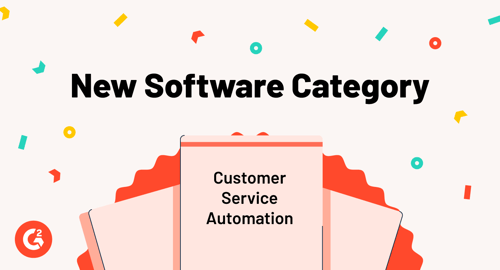Since the commercial introduction of generative AI models like ChatGPT, Bard, Llama 2, etc., companies have been scrambling to find the best business application for this new technology. The customer service software industry has traditionally been the test bed for new automation technologies.
Low-level customer support tasks are regularly automated by chatbots, self-service platforms, knowledge bases, and customer education materials. However, with the increasing capabilities of AI models, the potential for automation is expanding beyond basic tasks and toward more complex interactions.
This is driving the need for new solutions that can leverage these advancements and further transform the customer service landscape. In recognition of this growing trend, G2 created a new category for Customer Service Automation.
Gen AI provides reliable conversational automation
One of the remaining obstacles to the complete automation of customer service was the development of automating natural organic conversation. Instruments like interactive voice response (IVR) and chatbots have been cumbersome since these interactions tend to flow down a logic tree. These automations don’t consider nuance and context when trying to provide an excellent customer experience.
The newest customer service automation tools have finally bridged this technical gap. Interaction with the products in customer service automation software is organic. Although it may sound monotonous, it flows naturally as if the customer is speaking with a formal support agent.
These instruments are also becoming highly customizable and adaptable as they continue to provide service and learn from the customer and the agent. Some software platforms can directly connect with the company’s knowledge base and allow agents to add additional information, like planned service outages, into the knowledge base, which helps the AI model disseminate information quickly.
Understanding natural language in a conversation context allows the agent to communicate changes directly into the model.
G2 data shows rising interest in buyers toward customer service automation platforms
Since the launch of the Customer Service Automation category on G2's website, the category page has experienced a significant increase in site traffic. Conversely, the Help Desk category, which features more traditional customer service solutions, has seen a decrease in traffic over the same period.
This trend aligns with the growing adoption of generative AI models and the potential for automating more complex customer service interactions. Businesses are exploring customer service automation platforms to streamline operations, reduce costs, and improve customer experience with generative AI models.
However, it's important to note that while the site traffic data indicates rising interest, it does not necessarily reflect actual adoption rates or the long-term viability of these solutions. Challenges like hallucination, cost, and integration with existing systems will determine how much customer service automation platforms are adopted across various industries.
Known shortcomings of customer service automation
A major concern causing hesitation among early adopters is the problem of hallucination. In the AI context, hallucination is when AI models generate false information in response to an inquiry. This usually happens when the model doesn’t have an answer for the user and fabricates the best incorrect answer.
Providing incorrect information to customers negatively impacts customer satisfaction ratings once they discover the falsehood. Especially how easy it is for customers to ask a question for an answer the model isn’t trained on. Until this obstacle is overcome, many adopters will see these platforms as more risk than reward.
What’s in store for customer service automation?
Once the challenges of building cheaper models, reducing computational expenses, and overcoming hallucinations, rapid adoption of these technologies will force out many lagging competitors.
It is reasonable to predict a comparable extinction-level event where many customer service platforms that do not embrace Gen AI will be swept aside by innovation. The headcounts of many customer service departments will plummet along with department overhead costs.
Much like how customer success was a role that was created to satisfy the customer needs of the subscription-based SaaS products, there needs to be preparation for customer service engineers who specialize in prompt engineering to ensure their platform is up to date.
Explore G2’s latest developments in categorizing the AI software marketplace.
Edited by Shanti S Nair


 by Jeffrey Lin
by Jeffrey Lin
 by Jeffrey Lin
by Jeffrey Lin
 by Jeffrey Lin
by Jeffrey Lin